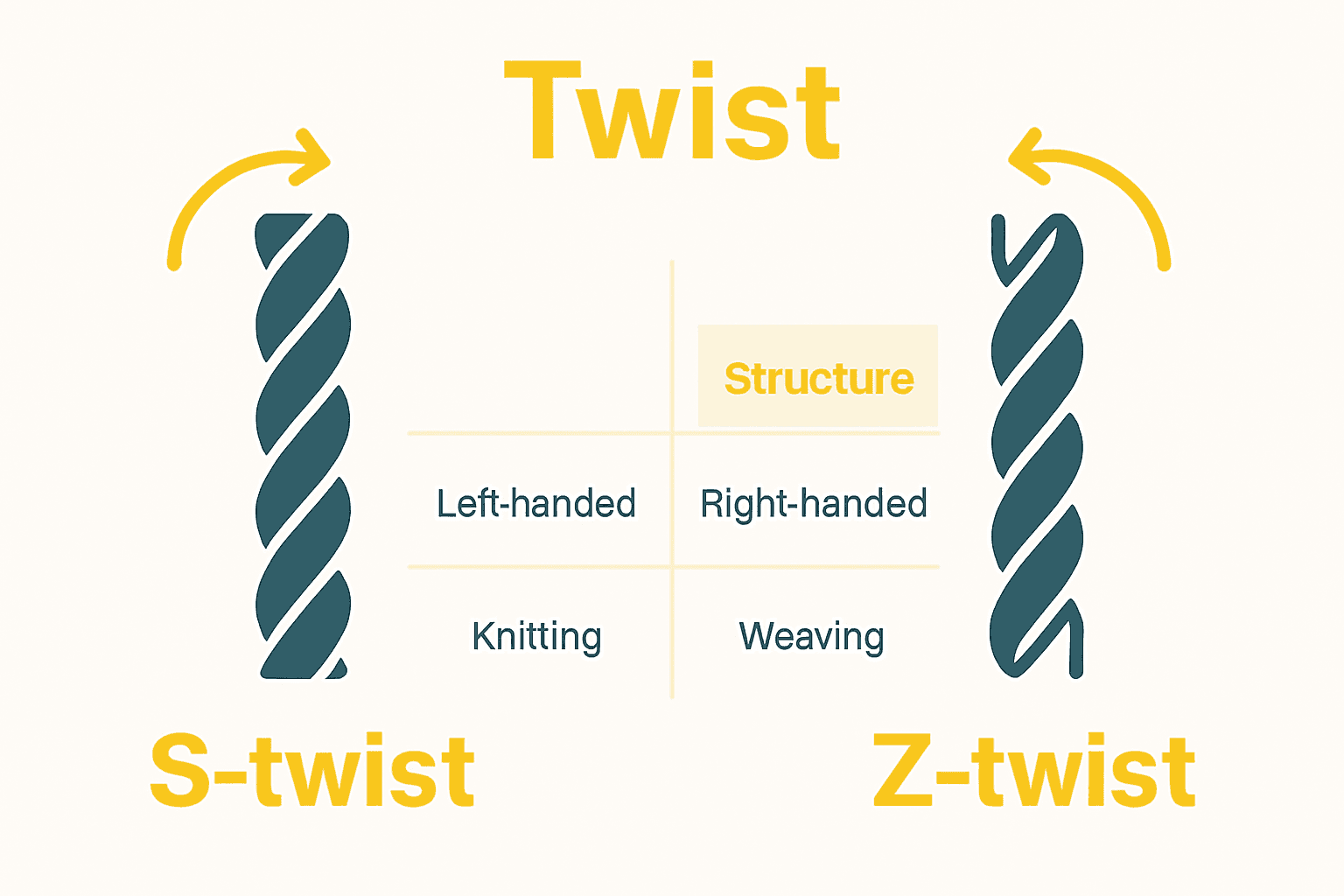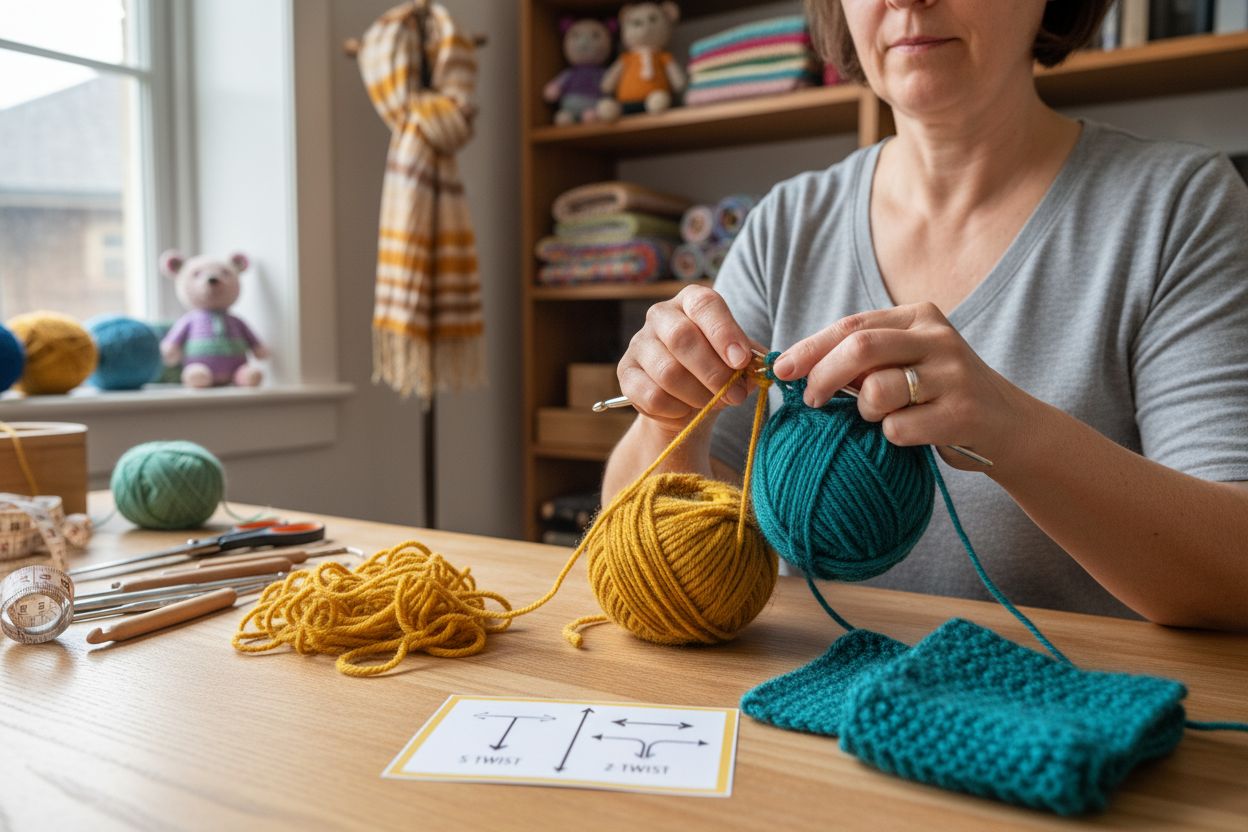
Complete Guide to the Role of Yarn Twist
Did you know that the amount and direction of yarn twist can completely change how a finished fabric feels and performs? Whether you are crafting for fun or striving for professional results, understanding this hidden force in every strand makes a huge difference. Yarn twist is more than just a step in production. It shapes strength, texture, and durability, giving crafters endless ways to customize and improve their projects.
Key Takeaways
| Point | Details |
|---|---|
| Understanding Yarn Twist | Yarn twist is essential in determining yarn strength, texture, and fabric characteristics, impacting both mechanical and aesthetic outcomes. |
| Types of Yarn Twist | S-twist and Z-twist are critical for yarn behavior, affecting crafting techniques and the final appearance of textiles. |
| Impact on Crafting | Awareness of twist direction is vital for avoiding issues like yarn splitting and achieving consistent tension during projects. |
| Common Mistakes | Crafters often face challenges related to twist direction, tension inconsistencies, and over-twisting, requiring strategic selection and techniques to optimize yarn performance. |
Table of Contents
- What Is Yarn Twist? Core Principles Explained
- Types of Yarn Twist: S-Twist, Z-Twist, and More
- How Twist Affects Yarn Strength and Performance
- Yarn Twist in Crochet and Knitting Projects
- Common Mistakes With Yarn Twist and Solutions
What Is Yarn Twist? Core Principles Explained
Yarn twist is the fundamental technique where fibers are spirally arranged around the yarn’s central axis, creating a complex structural mechanism that transforms loose fibers into a strong, cohesive strand. According to research from textile experts, this twisting process is far more than a simple mechanical operation - it’s a critical engineering approach that determines the yarn’s fundamental characteristics.
At its core, yarn twist serves multiple essential functions. As documented by Understanding the Role of Yarn Spin in Crafting, the primary purposes include:
- Binding fibers together through increased friction
- Enhancing the yarn’s tensile strength
- Improving overall structural integrity
- Creating unique fabric textures and performance properties
The amount of twist is typically measured in turns per inch, which directly impacts the yarn’s final performance. Less twist produces softer, more relaxed yarns ideal for lightweight fabrics, while higher twist levels create firmer, more durable strands perfect for robust textiles. Crafters can strategically manipulate twist to achieve specific outcomes in their projects, transforming seemingly simple fibers into complex, purposeful materials.
Interestingly, twist isn’t just about mechanics - it’s an art form. Textile researchers note that different twist directions (S-twist and Z-twist) and varied intensity levels enable crafters to create extraordinarily diverse fabric effects. This nuanced approach turns yarn production from a simple manufacturing process into a sophisticated craft requiring deep understanding of fiber behavior.
Types of Yarn Twist: S-Twist, Z-Twist, and More
Yarn twist is a nuanced craft that goes beyond simple fiber arrangement, with two primary twist directions that fundamentally define a yarn’s character: S-twist and Z-twist. According to Understanding Twisted vs Plied Yarn: Key Differences, these twist directions are named after the way fibers slope, mimicking the central lines of the letters S and Z.
The key characteristics of S-twist and Z-twist include:
- S-Twist: Fibers slope from lower left to upper right, resembling the center line of an S
- Z-Twist: Fibers slope from lower right to upper left, mimicking the center line of a Z
- Twist direction impacts yarn strength, texture, and fabric behavior
- Professional crafters can strategically choose twist direction for specific project needs


Here’s a comparison of S-twist and Z-twist yarn characteristics:
| Twist Type | Fiber Slope Direction | Common Uses | Crafting Impact |
|---|---|---|---|
| S-Twist | Lower left to upper right | Knitting Soft fabrics |
Can untwist during right-handed crochet Prone to splitting |
| Z-Twist | Lower right to upper left | Crochet Durable textiles |
More stable with right-handed crochet Fewer splitting issues |
Beyond basic S and Z twists, specialized techniques like crepe yarns emerge. These yarns use extremely high twist levels to produce unique kink effects, creating extraordinary texture variations. Textile researchers note that by combining opposing twist directions in a finished fabric, crafters can generate stunning shadow and texture effects that transform ordinary materials into intricate, visually compelling textiles.
Interestingly, plied yarns introduce another layer of complexity. In these advanced yarn constructions, individual single yarns are first twisted in one direction, then plied together in the opposite direction. This technique enhances yarn stability and allows for more sophisticated fabric design, demonstrating the incredible versatility of twist as a fundamental yarn-crafting principle.
How Twist Affects Yarn Strength and Performance
Yarn twist is a delicate balance of engineering and craftsmanship, directly influencing the yarn’s overall strength, durability, and performance characteristics. According to research, twist plays a critical role in fiber cohesion, with Understanding Why Yarn Quality Matters highlighting the nuanced relationship between twist and yarn integrity.
The key performance impacts of yarn twist include:
- Fiber Cohesion: Increasing lateral pressure between fibers
- Reduced Slippage: Minimizing fiber movement and separation
- Tensile Strength: Enhancing overall yarn durability
- Structural Integrity: Creating a more compact and resilient yarn structure
However, twist is not a simple ‘more is better’ equation. Scientific studies reveal that excessive twist can actually introduce internal stress and compromise yarn strength. In cotton fabrics, researchers discovered that while increased twist improves tensile properties, it simultaneously reduces sensorial comfort - affecting characteristics like stretching, softness, and surface texture.
The optimal twist varies significantly depending on fiber type, intended use, and desired performance characteristics. Crafters must carefully balance twist levels to achieve the perfect combination of strength, flexibility, and aesthetic qualities. This intricate process transforms yarn from a simple collection of fibers into a sophisticated material capable of meeting complex textile design requirements.
Yarn Twist in Crochet and Knitting Projects
Understanding yarn twist is crucial for crafters, as it significantly impacts the performance and appearance of crochet and knitting projects. How to Crochet with Yarn: Your Ultimate Beginner’s Guide highlights the importance of twist direction in creating successful textile work.
The fascinating dynamics of yarn twist in crafting reveal some critical insights:
- Right-handed Crochet: Tends to untwist S-twist yarns
- S-Twist Yarns: More prone to splitting during crafting
- Z-Twist Yarns: Generally more stable and resilient
- Knitting Mechanics: Differently impacts yarn twist compared to crocheting
Crafters must develop a keen awareness of twist direction to prevent common issues like yarn splitting and uneven tension. For right-handed crocheters, S-twist yarns can become problematic, as the crafting motion naturally untwists these fibers, potentially creating weak spots or inconsistent texture. Conversely, Z-twist yarns tend to be strengthened by the crocheting motion, offering more structural integrity.
The subtle interplay between twist direction and crafting technique transforms yarn selection from a simple choice to a strategic decision. Experienced crafters learn to ‘read’ their yarn, understanding how its inherent twist will interact with their specific crafting style, ultimately creating more polished and professional-looking projects.
Common Mistakes With Yarn Twist and Solutions
Yarn twist can transform from a crafting ally to a challenging obstacle when not understood properly. What Is Splitting Yarn? Complete Guide for Crafters reveals the nuanced problems crafters encounter with yarn twist, highlighting the need for strategic approach and awareness.
The most common yarn twist mistakes include:
- Ignoring Twist Direction: Using inappropriate twist for crafting technique
- Inconsistent Tension: Creating uneven fabric due to twist-related issues
- Yarn Splitting: Particularly problematic with loosely spun yarns
- Over-twisting: Causing yarn to become stiff and difficult to work with
Right-handed crocheters frequently struggle with S-twist yarns, which naturally unravel during crafting and create frustrating splitting. Professional crafters recommend several practical solutions: selecting Z-twist yarns, using more tightly spun yarn varieties, and implementing techniques like allowing the skein to rotate freely during work to minimize unwanted twisting.
Mastering yarn twist requires patience and experimentation. By understanding how different twist directions interact with various crafting techniques, you can transform potential frustrations into opportunities for creating more polished, professional-looking textile projects. The key is developing an intuitive relationship with your yarn, learning to ‘read’ its inherent characteristics and adapt your technique accordingly.
Take Control of Your Yarn Twist for Flawless Projects
Are you tired of loose fibers, splitting yarn, or unpredictable results when trying new techniques described in the Complete Guide to the Role of Yarn Twist? Finding the right yarn with proper twist and the best tools for your creative vision can be stressful. At Craftiss, we know yarn twist is essential for strength, texture, and structure in every crochet or knitting project. That is why our Yarn collection is thoughtfully curated with a variety of twist levels to solve common crafting frustrations and unlock professional results every time.
.png)
Stop letting confusion over S-twist, Z-twist, or plied yarn slow you down. Explore Yarn for the perfect match or visit CRAFTISS to shop all your crochet essentials now. For makers who love to craft anywhere, don’t forget our Yarn Bags keep your projects organized and your yarn protected from unwanted tangles. Your next masterpiece starts with the right twist—shop at Craftiss today.
Frequently Asked Questions
What is yarn twist?
Yarn twist is the technique of spirally arranging fibers around the yarn’s central axis, which enhances the yarn’s strength, texture, and performance characteristics.
How does twist direction affect yarn performance?
The twist direction, either S-twist or Z-twist, affects the yarn’s strength and behavior in crafting. S-twist yarns are more prone to splitting during right-handed crocheting, while Z-twist yarns generally offer more stability and resilience.
What is the impact of yarn twist on knitting and crocheting?
Yarn twist greatly influences the ease of crafting. S-twist yarns may cause issues such as untwisting and uneven tension in right-handed crocheting, making Z-twist yarns a better choice for this technique.
How can I avoid common mistakes related to yarn twist?
To prevent issues like yarn splitting and inconsistent tension, choose the appropriate twist direction for your crafting technique, maintain uniform tension, and consider using tightly spun yarns.


